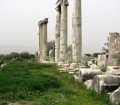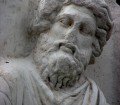Preschool, Primary and Secondary Education
There are schools in all our villages. However, because some of the villages do not have enough students or the physical conditions are insufficient, transportation education is carried out. Transportation expenses of the students who are transported within the framework of transportation are covered by the Provincial Special Administration and lunch expenses are also met by the District National Education Directorate.
ADSL connection was made to all of our Primary Class Primary Schools and computers were sent to these schools through the Ministry of Transport.
In the 2008-2009 Academic Year, a total of 797 students are transferred to 6 primary schools selected as centers and lunch is given to these students.
1 High School, 1 Anatolian High School, 1 Public Education Center, 1 Vocational and Technical Education Center (METEM); There are 9 primary schools, 1 kindergarten, 10 primary schools, 1 Teacher’s House, 1 Private Driving Course and 1 Private Classroom. In addition, METEM has kindergarten in Applied Kindergarten, Ataeymir, Yenice, Geyre, Ataköy, Yaykın, Işıklar, Alemler and Atatürk Primary Schools. A total of 217 students and a total of 757 students are educated in elementary schools.
Karacasu Anatolian High School started education in 2005, 1 Manager, 1 deputy director, 1 Data Preparation and Control Operator (Temporary Officer), 1 retainer, 19 teachers, 204 students continue education. Partial repair. New computer lab was established. The new service building is built by a charity called Kemal İPBAŞ. The ground floor rough construction is completed and the other floor construction works are in progress.
The reading-writing ratio is approximately 99%. Literate people, usually over the age of 65 are citizens. According to the needs of the public education center in the mother-daughter school reading-writing courses are opened within the scope of reading-writing campaigns.
High Education
There is Karacasu Memnune İnci Vocational School in Adnan Menderes University. Our school was established in 2000 with 2 programs. Leather and Ceramic Programs. In 2002, Marketing Program and Jewelry Design and Ornamental Stone Processing, in 2005 Accounting, Business Administration, Foreign Trade, Marketing, Tourism and Hotel Management, Tourism and Hotel Management Programs were opened; There are a total of 1,067 students in 2008-2009 Academic Year.
In 2006-2007, Tekel building, which was taken over by the SDIF as a result of correspondence, was financed by businessman Architect İrfan BEZCİ and the workshops were taken under a single roof. This new building was named Nuray-İrfan BEZCİ Campus and opened to service in 2007-2008 academic year.
2007 In 2008, İNCİ HOLDİNG Foundation member Memnune İNCİ HALAR has signed a protocol for the construction of a new school building for donation to our school.
The leather workshop of our high school is located in Dandalaz area of Karacasu.
Special Education
There are Private Öz Karacasu Driving School and Special Level Courses in the District Center.
Dormitories and Hostels
Student Accommodation Center with a capacity of 54 students belonging to Teachers’ House and Karacasu Education and Development Foundation; Provided an operating license by the municipalities in the District Center, there are 9 real and legal persons student boarding houses.
Sport
Youth and sports activities in the district are organized by District Youth and Sports Directorate. Sports facilities include Karacasu Football Field and Indoor Sports Hall. It was germinated in the Karacasu football field. The construction of the Yenice Beldesi Football Field was completed and put into operation as of the end of 2005. The fine construction of Ataeymir Municipality Football Field locker rooms has been completed and started to operate.
Karacasu, Yenice and Ataeymir Sports Clubs are fighting in the amateur cluster.
Sports, football, volleyball, basketball, billiards, cross-country, chess, Wushu / Kikcboks etc. sports competitions are organized in the district with the organization of District Governorate, Municipality, Karacasu Foundation and Karacasu Sports Club.
Wu Shu Sports representing our province and our district branches across Turkey are participating in the championship and achievements made in Turkey are obtained.
Culture
In our town, there is the ancient city of Aphrodisias, which is one of Turkey’s most important cultural assets. The ancient city of Aphrodisias is located within the boundaries of the town of Geyre, 13 km from our district. In our district, there is the Aphrodisias Museum, where works from the Ancient City of Aphrodisias are displayed.
In 1835, the first research in the Ancient City of Aphrodisias was carried out by Laborde and Texier on behalf of the Dilletanti Association. The first excavations were carried out by a French engineer named Paul Gaudin and an amateur archeologist between 1904-1905. In 1937 the Italian G. Jacobi excavated in the Aphrodisias Agora. Between the years 1961-1990 on behalf of New York University. Dr. Systematic excavations and research were carried out by Kenan T. ERİM and a large part of the present remains were unearthed during this period. From 1991 to the excavations and research Prof. Dr. It is being continued by R. SMITH.
In the archaeological excavations carried out at the Akropol Tepesi Höyük located within the Aphrodisias Ruins; Chalcolithic ceramics, sileks and obsidian tools dating to 4,000 years were removed. In addition, a chalcolithic flat settlement area, which yielded Hacilar type painted ceramic finds, was identified in Yenice Bucağı Akyar Değirmeni Mevkii.
The region is an important settlement in the Bronze Age. The Akropol and Pekmez Tepe Mounds within the Aphrodisias Archaeological site, which yielded archaeological investigations, yielded important finds covering all layers of the Bronze Age. These finds, which come together with the products of the Central Anatolian Bronze Age civilizations, document that there is an advanced trade and culture exchange in the region. In addition, an early Bronze Age Necropolis was discovered within the boundaries of the Güzelbeyli Village.
In the excavations of Aphrodisias, Iron Age, Lydian-type ceramic layers, and Archaic and Classical Period settlement were found around the Akropol Tepe Höyük and Afrodite Temple.
BC Aphrodisias, the most important ancient city of the region within a thousand years, the goddess Ishtar in the Asian origin, the goddess Kybele of Anatolian origin and the Goddess Aphrodite cemetery of the Greek origin, a combination of the goddess of nature and fertility Aphrodisias Aphrodite cult began to develop and the city of Aphrodite has become a cult center.
In the late Hellenistic period, two ancient cities in the region began to develop. The ancient cities of Aphrodisias and Plaraza developed rapidly during the Roman period, especially during the emperors from the Julius-Claudius family. Privileges and autonomy were granted by Rome and the two cities jointly coins. Aphrodisias has become an important Plastic Arts Center (Sculpture School) with the use of marble quarries around it. Region, İ.S. It continued to develop until the 4th century and its importance remained.
In the Byzantine period, Aphrodisias was transformed into the Archbishop of the Carian Region. BUSINESS. 6-11. In the 17th century, the region lost its importance due to the political, religious and economic problems and the Visigoth and Arab invasions.
The main monumental buildings uncovered in the excavations in Afrodisias include:
- Temple of Afrodite
- Tetrapylon
- Stadium
- Odeon
- School of Philosophy
- Bishop’s Palace
- Hadrian’s Baths
- Tiberius Portico
- Agora
- Basilica
- Theater and Theater Baths
- Tetrastoon and Emperors Hall
- Sebasteion
- The Martyrion
In 1947, to protect the finds from the Aphrodisias Ruins, a former Deveci Khan was converted into a museum depot in the Old Geyre Village of the General Directorate of Antiquities and Museums and a guard was appointed. In 1967, the staff of the guard was increased and a civil servant was appointed. In 1972, the first assistant was appointed and the existing museum building was started. Since 1977, the exhibition was organized and the museum was opened to visitors on 21.07.1979. The ancient city of Aphrodisias, in which the museum was built, is the unit of the museum.
The Aphrodisias Museum is a local museum, which is generally exhibited in the excavations of the ancient city of Aphrodisias. Excavations at the Akropol Tepesi and Pekmez Tepe Mounds within the ruins of the small artifacts and the Chalcolithic Period, prehistoric artifacts from the early, middle and late periods of the Bronze Age. Roman, Byzantine and early Islamic artifacts are exhibited in the excavations.
The most important part of the collection of museum work is BC. In the 1st century, it was founded in the Late Hellenistic Period. A variety of sarcophagi are produced by the numerous sculptures and reliefs of the Aphrodisias School of Sculpture, which continued to exist until the 5th century Early Byzantine Period. Some examples of these plastic works are the Zoilos Frieze, the Melpomene Statue, the various statues of the emperor, the statue of Polykleitos, Diskophoros.
The most important part of the collection of museum work is BC. In the 1st century, it was founded in the Late Hellenistic Period. A variety of sarcophagi are produced by the numerous sculptures and reliefs of the Aphrodisias School of Sculpture, which continued to exist until the 5th century Early Byzantine Period. Examples of these plastic works are the Zoilos Frieze, the Melpomene Statue, various emperor statues, the statue of Polykleitos Diskophoros, İ.S.1. We can show the 21st century copy, the Akhilleus-Pentexhesileia Group, the Statues of Baby Dionysus and Satyr, the various Nike Sculptures, the cult statue of Aftodisias Aphrodite, the priest and nun statues and the Demos Sculpture.
The high relief groups of the struggle for Amazonmakhi, Gigantomakhi and Kentaur-Lapit in the Agora gate and the high relief panels of the Sebasteion building group are preserved in the excavation house workshop due to the restoration work of the excavation team.
Since May 2008, the exhibition was presented at the Aphrodisias Museum Sevgi Gönül / Sebasteion Hall, which was already in service. In order to apply the museum to other contemporary exhibition halls and to bring the museum display to a completely contemporary view, the exhibition was opened in all exhibition areas except Sevgi Gönül / Sebasteion Hall. repair ”. As of today, the reports of the study, which is planned to be carried out with the support of the Geyre Foundation, are still under the approval of our Ministry.
The Ethnography Museum was completed in the new building of the municipality in the district center and started to operate in 2007 / August. The works of exhibiting and arranging, ethnographic works and works reflecting the culture of the region are continuing. It was transferred to the Ministry of Culture.
The newly created Aphrodisias Museum Sevgi Gönül / Sebasteion exhibition hall within the body of Aphrodisias Museum was exhibited in 2008.
There are Public Libraries in the Town Center, Ataeymir and Yenice Townships and they serve in municipal buildings. Ataeymir Public Library is closed due to lack of personnel.
There is no printing house, bookstore, cinema and theater in the district. There are 7 internet cafes in the district center, 7 in Yenice and Ataeymir.








